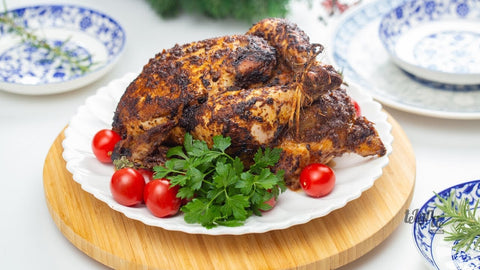Peppers grew only in Latin America back in the day, up until the Spanish and Portuguese explored the New World. These explorers introduced peppers alongside corn, tomatoes and beans to their countries and distributed them to other countries - the spread was like wildfire. Today, peppers have become integral to foods in Africa.
All kinds of peppers introduced by these explorers are part of the genus Capsicum; they include hot varieties known as chilli peppers and sweet varieties such as bell peppers.
READ HOW TO STICK TO A CHRISTMAS BUDGET
The spice level of a pepper is measured using Scoville units: the scale ranges from 0 - like the sweet Bell Peppers - to 3,000,000 - like the spiciest pepper in the world called Carolina Reaper. The Scoville scale is a good base for knowing how hot your chilli peppers are, but the heat varies according to climate and vegetation.
You can relish the flavour without the mouth-scorching fire by removing the seeds and interior ribs from chilli peppers before cooking them. Don't forget to protect your skin by wearing gloves and never touching your eyes when handling hot peppers.
Here are 15 kinds of peppers with their botanical names and spice levels;
1. Bell Pepper
Botanical Name: Capsicum annuum
Spice Level: 0
Bell peppers are mostly immaturely green with a slightly bitter flavour. As it matures, it turns bright red and becomes sweeter. You can also find yellow, orange, white, pink, and even purple varieties. With their high water content, bell peppers will add moisture to any dish. They're also great for adding colour.

2. Banana Pepper
Botanical Name: Capsicum annuum
Spice Level: 0 - 500
This mild yet tangy pepper adds a kick to pizza or sandwiches. This pepper usually takes on a bright yellow hue as it ripens but occasionally grows to be red, orange or green instead.

3. Cherry Pepper
Botanical Name: Capsicum frutescens
Spice Level: 500
This lovely pepper is sweet on the outside and the inside. Bright red and shaped like a heart, this large pepper is barely spicy and makes up for its lack of spice with a sweet, succulent flavor. You'll commonly find cherry peppers chopped and stuffed into green olives.

4. Shishito
Botanical Name: Capsicum annuum var. grossum
Spice Level: 50 - 200
Harvested while still green, these thin-walled peppers can be pan-seared and eaten on their own. They can also be added to pizza or flavour dishes. The riper the shishito, the spicier the pepper.

5. Piquillo Pepper
Botanical Name: Capsicum annuum
Spice Level: 500 - 1,000
Similar to red bell pepper, it can be used to cook many dishes. However, it is thinner, sweeter, and more delicate than a bell pepper. The possibilities with how to cook piquillo peppers are endless. It can be deliciously stuffed with tuna, goat cheese, chicken or even crab.

6. Poblano Pepper (Tatashe in Nigeria)
Botanical Name: Capsicum annuum
Spice Level: 1,000 - 2,000
Also known as Ancho, the poblano is common in Mexican dishes such as chiles Rellenos. At maturity, the poblano turns dark red-brown and can be dried, at which point it's referred to as an ancho or mulato. Anchos have a rich, raisin-like sweetness. The high yield of flesh to skin makes anchos great for sauces.

7. Anaheim Pepper
Botanical Name: Capsicum annuum
Spice Level: 500 - 2,500
Popular in salsas and dishes from the American Southwest, Anaheim pepper is relatively mild and very versatile. When mature, it turns deep red and is referred to as a chile Colorado or California red chile.

8. Jalapeno Pepper
Botanical Name: Capsicum annuum
Spice Level: 3,500 - 8,000
Mexican pepper is typically plucked from the vine while still green. If left to ripen more, they will turn red and take on a slightly fruity flavor. Jalapeños are a tasty ingredient commonly used in salsa and sauces. Smoky, woodsy, and spicy, jalapeños are the perfect ingredient for salsas, sauces, escabeche, and adobo.

9. Ghost Pepper
Botanical Name: Capsicum Chinese
Spice Level: 1, 000, 000+
One of the hottest edible peppers in the world, the ghost pepper hails from Northeastern India with more than 1 million Scoville units. It's approximately half as hot as the pepper spray used by law enforcement but 100 times spicier than a jalapeno.

10. Serrano Pepper
Botanical Name: Capsicum annuum
Spice Level: 6,000 - 23,000
Common in Mexican and Thai cooking, Serranos can be cooked in their ripe and unripe states. The smaller the pepper, the hotter it is. When ripened, they get red or yellowish orange.

11. Scotch Bonnet (Ata-Rodo in Nigeria)
Botanical Name: Capsicum chinense
Spice Level: 80,000–400,000
Scotch bonnet is the hottest pepper in the Caribbean and is used to flavour various African dishes, including chicken. Though the pepper is often spicy, you will occasionally find a sweet variety called cachucha.

12. Habanero Pepper (Ata-Rodo in Nigeria)
Botanical Name: Capsicum chinense
Spice Level: 150,000 - 350,000
In the same family as the Scotch Bonnet, Habanero is one of the hottest peppers. It also has a fruity flavour after the spice fades. It's popular on Mexico's Yucatan Peninsula and in the Caribbean, where hot sauces are made.

13. Cayenne Pepper (Ata-Sombo in Nigeria)
Botanical Name: Capsicum chinense
Spice Level: 30,000 - 50,000
Slender and tapered, this chile is probably most familiar in its dried, ground form—the powder known as cayenne pepper. Ground cayenne pepper is the main ingredient in the chilli powder that flavours Tex-Mex dishes such as chilli con Carne. It's one of the spiciest types of peppers!

14. Rocoto Pepper
Botanical Name: Capsicum chinense
Spice Level: 100,000 - 250,000
This South American pepper looks like a miniature bell pepper, and, like a bell pepper, can come in shades of orange, yellow and red. The hottest rocotos are typically yellow, but red rocotos are the most common. Inside, the pepper has unique black seeds. It's sometimes referred to as the hairy pepper thanks to its furry leaves. Rocoto has a crisp and fruity flavor.

15. Piri Piri
Botanical Name: Capsicum frutescens
Spice Level: 50,000 - 175,000
Also known as bird's eyes, its source is the Portuguese African method of cooking prawns, chicken, or anything else in this sauce. Though it's a relatively small pepper, growing only one to two inches, it packs quite a punch.








Comments (5)
Winning the lottery was never something I dreamt of. My name is Charles Coffey, a retired Royal Bank of Canada (RBC) . I dedicate more than four decades of my life to Canada’s largest Bank. I served as RBC executive vice president of government affairs and business development before retiring in 2006.but this win gives me the opportunity to sustain and support the causes i have championed for decades. This is the fact concerning my winning. I saw a comment online about how Dr Marcus helped her to win the lottery. I said let me give this a try. I contacted him, we talked and all the necessary things were done. To be honest I never believed in spells. The following week he directed me to go get a ticket, i went to purchase the winning ticket from a shell gas station on Yonge street. the next day i was filling up my car at the gas station when i went inside to grab a chocolate bar and check my lotto max ticket on my surprise i won the top prize in Ontario Lottery of $25,000,000 i thought i won $25,000 but after taking a closer look i realized i miscalculated by three extra zeros, (spell do works i said to myself) I recommend Dr marcus he has the power and capacity to make the impossible possible, reach him at drmacusspellcaster@gmail.com or +2348110492028 whatsapp number. Hopefully you get a quick response from him
Am here to let the whole world know that I was diagnose of herpes 3 years ago where all hope was lost and I had nothing to do about it,I just accepted the faith that one day I will cure of this disease and I just pray everyday for a helper and one day my sister introduce me to a herbal doctor man called Dr ahonsie that she saw him on internet well I contact him on his email,I was not fully convinced until he sent me the herbal medicine which he ask me to take for two weeks I took it with faith and i went for a retest in different hospitals and today am cured of this disease and am also using this medium to let all those having STD,like herpes and the rest not to give up,their is a man who can cure you,his name is Dr ahonsie . contact the great herbalist via his Email: drahonsie00@gmail.com / WhatsApp: +2348039482367. https://drahonsie002.wixsite.com/dr-ahonsie
Hello everyone, i have a very important information about herpes virus, i was a victim of hsv1&2 until i met doctor Ahonsie, it still feels like a dream to me. it has been two years now, i have not experience any breakout of herpes. I new about him through a post made on social media, a lady shares her experience and then i decided to contact him and ever since i contacted i was encourage and with no doubt i was cured from herpes simplex in just two weeks. He also treat other illnesses like HPV, HIV, CANCER, THYRIOD, PENIS ENLARGEMENT, and more contact him via Email: drahonsie00@gmail.com / WhatsApp: +2348039482367. https://drahonsie002.wixsite.com/dr-ahonsie https://www.facebook.com/drstellaherbalhome?mibextid=ZbWKwLThanks
I thought the physicians says there is no cure for HSV 2!!! I am telling you today that Dr ahonsie cure HSV 2 with his herbal medicine and once you get cured you are cured forever it is never reversible, I have been suffering for this deadly disease called h HSV 2 for more than a 2years and lost all hope because my doctor says there is no cure for HSV 2. Brethren I saw a testimony on the internet on how Dr ahonsie cure HSV, Hapatitis etc with his herbal medication and an email and watsapp to contact him was also displayed, I thought this was joke but I decided to contact him and he replied telling me not to worry that my problem is over . Dr ahonsie sent me a herbal medication to drink for one month but only 2weeks I feel strange and I went to my doctor and he confirmed me negative. He can help you too. Contact him drahonsie00@gmail.com or whatsapp +2348039482367 https://drahonsie002.wixsite.com/dr-ahonsie https://www.facebook.com/drstellaherbalhome?mibextid=ZbWKwL
Being the winner of a multi-million-dollar lottery certainly is a life-changing event for almost every single lottery winner. My name is Mavis Wanczyk from Chicopee, Massachusetts, the famous Powerball lottery winner of $758 million (£591m). I know many people would wonder how I had won the lottery. Would you believe me if I told you that I did it with spell casting? I met this famous spell caster known as Great Odunga and he was the one who did it for me. As shocking as it was to me, my famous comment to the press was “ I’m going to go and hide in my bed.” Never did I believe that Great Odunga made me wealthy overnight. If you want to have your chance of winning and becoming very wealthy just like me, contact Great Odunga at odungaspelltemple@outlook.com OR Email: odungaspelltemple@gmail.com and WHATS-APP HIM at +2348167159012 and you will be lucky. Thanks for reading and hope to see you at the top